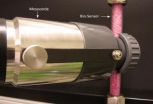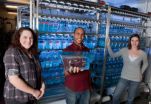(Press-News.org) CHAMPAIGN, Ill. — Good news for control freaks! New research confirms that having some authority over how one takes in new information significantly enhances one's ability to remember it. The study, in the journal Nature Neuroscience, also offers a first look at the network of brain structures that contribute to this phenomenon.
"Having active control over a learning situation is very powerful and we're beginning to understand why," said University of Illinois psychology and Beckman Institute professor Neal Cohen, who led the study with postdoctoral researcher Joel Voss. "Whole swaths of the brain not only turn on, but also get functionally connected when you're actively exploring the world."
The study focused on activity in several brain regions, including the hippocampus, located in the brain's medial temporal lobes, near the ears. Researchers have known for decades that the hippocampus is vital to memory, in part because those who lose hippocampal function as a result of illness or injury also lose their ability to fully form and retain new memories.
But the hippocampus doesn't act alone. Robust neural connections tie it to other important brain structures, and traffic on these data highways flows in both directions. Functional magnetic resonance imaging (fMRI) studies, which track blood flow in the brain, show that the hippocampus is functionally connected to several brain networks – distinct regions of the brain that work in tandem to accomplish critical tasks.
To better understand how these brain regions influence active versus passive learning, Voss designed an experiment that required participants to memorize an array of objects and their exact locations in a grid on a computer monitor. A gray screen with a window in it revealed only one object at a time. The "active" study subjects used a computer mouse to guide the window to view the objects.
"They could inspect whatever they wanted, however they wanted, in whatever order for however much time they wanted, and they were just told to memorize everything on the screen," Voss said. The "passive" learners viewed a replay of the window movements recorded in a previous trial by an active subject.
Then participants were asked to select the items they had seen and place them in their correct positions on the screen. After a trial, the active and passive subjects switched roles and repeated the task with a new array of objects.
The study found significant differences in brain activity in the active and passive learners.
Those who had active control over the viewing window were significantly better than their peers at identifying the original objects and their locations, the researchers found. Further experiments, in which the passive subjects used a mouse that moved but did not control the viewing window, established that this effect was independent of the act of moving the mouse.
To identify the brain mechanisms that enhanced learning in the active subjects, the researchers repeated the trials, this time testing individuals who had amnesia – a disease characterized by impairment in learning new information – as a result of hippocampal damage. To the surprise of the researchers, these participants failed to benefit from actively controlling the viewing window.
"These data suggest that the hippocampus has a role not just in the formation of new memory but possibly also in the beneficial effects of volitional control on memory," the researchers wrote.
Brain imaging (by means of fMRI) of healthy young subjects engaged in the same active and passive learning tests revealed that hippocampal activity was highest in the active subjects' brains during these tests. Several other brain structures were also more engaged when the subject controlled the viewing window, and activity in these brain regions was more synchronized with that of the hippocampus than in the passive trials.
Activity in the dorsolateral prefrontal cortex, the cerebellum and the hippocampus (see cartoon) was higher, and more highly coordinated, in participants who did well on spatial recall, the researchers found. Increased activity in the inferior parietal lobe, the parahippocampal cortex and the hippocampus (see cartoon) corresponded to better performance on item recognition.
"Lo and behold," Cohen said, "our friend the hippocampus makes a very conspicuous appearance in active learning."
The new findings challenge previous ideas about the role of the hippocampus in learning, Voss said. It is a surprise, he said, that other brain regions that are known to be involved in planning and strategizing, for instance, "can't do very much unless they can interact with the hippocampus."
Rather than being a passive player in learning, the hippocampus "is more like an integral part of an airplane guidance system," Voss said. "You have all this velocity information, you have a destination target and every millisecond it's taking in information about where you're headed, comparing it to where you need to go, and correcting and updating it."
INFORMATION:
Editor's notes: To reach Neal Cohen, call 217-244-4339; e-mail njc@illinois.edu.
To reach Joel Voss, e-mail joelvoss@illinois.edu.
The paper, "Hippocampal Brain-network Coordination During Volitional Exploratory Behavior Enhances Learning," is available online or from the U. of I. News Bureau.
Study reveals how taking an active role in learning enhances memory
2010-12-07
ELSE PRESS RELEASES FROM THIS DATE:
AgriLife researchers find way to cut food-irradiation levels by half
2010-12-07
COLLEGE STATION — A team of Texas AgriLife Research engineers has developed a way to cut by as much as half the amount of irradiation needed to kill 99.999 percent of salmonella, E. coli and other pathogens on fresh produce.
By packing produce in a Mylar bag filled with pure oxygen, Dr. Carmen Gomes, AgriLife Research food safety engineer, and her colleagues found they could significantly reduce the amount of radiation needed to kill those pathogens. Reducing the amount of radiation is not so much a safety measure as it is a way to preserve quality of the produce, she ...
Report finds K-12 computer science education declining
2010-12-07
PITTSBURGH—Computer-related technology is increasingly driving the U.S. economy, yet computer science education is scant in most American elementary and secondary school classrooms and the number of introductory and Advanced Placement courses in computer science has actually declined in the last five years, according to a report released this fall.
"Some states and some schools are offering some really excellent courses," said Mark Stehlik, co-author of the report, "Running on Empty: The Failure to Teach K-12 Computer Science in the Digital Age," http://www.acm.org/runningonempty/. ...
Fledgling ecosystem at Chicken Creek lets scientists observe how soil, flora and fauna develop
2010-12-07
How do ecosystems develop? No one really knows, yet. There is however one project, unique in the world, seeking to answer this question. In a former open-pit coal mining area in Brandenburg, Germany, a surface of six hectares was partitioned off and then left to its own resources. Scientists from the Technische Universitaet Muenchen (TUM), in collaboration with researchers from other institutions, are studying the development of soil, flora, and fauna there. With this research they aim to establish the factors that have a particularly strong influence on developing ecosystems.
Young ...
Drug prevents post-traumatic stress syndrome
2010-12-07
CHICAGO --- Post-traumatic stress syndrome – when a severely stressful event triggers exaggerated and chronic fear – affects nearly 8 million people in the United States and is hard to treat. In a preclinical study, Northwestern Medicine scientists have for the first time identified the molecular cause of the debilitating condition and prevented it from occurring by injecting calming drugs into the brain within five hours of a traumatic event.
Northwestern researchers discovered the brain becomes overly stimulated after a traumatic event causes an ongoing, frenzied ...
Pure nanotube-type growth edges toward the possible
2010-12-07
New research at Rice University could ultimately show scientists the way to make batches of nanotubes of a single type.
A paper in the online journal Physical Review Letters unveils an elegant formula by Rice University physicist Boris Yakobson and his colleagues that defines the energy of a piece of graphene cut at any angle.
Yakobson, a professor in mechanical engineering and materials science and of chemistry, said this alone is significant because the way graphene handles energy depends upon the angle -- or chirality -- of its edge, and solving that process for ...
Early safety results promising for Phase I/II trial of gene therapy treatment of hemophilia B
2010-12-07
Investigators report no evidence of toxicity in the four hemophilia B patients enrolled to date in a gene therapy trial using a vector under development at St. Jude Children's Research Hospital and UCL (University College London) to correct the inherited bleeding disorder.
This trial was designed primarily as a safety test, with low and intermediate doses of the vector expected to produce little detectable Factor IX. The Factor IX protein helps the blood form clots. Individual with hemophilia B lack adequate levels of this clotting factor. The first participant in the ...
People with severe mental illness 12 times more likely to commit suicide
2010-12-07
People with psychotic disorders, such as schizophrenia or bipolar disorder, are 12 times more likely to commit suicide than average, according to research released today by King's Health Partners.
The research found that the rate of suicide was highest in the first year following diagnosis (12 times national average) and that high risk persisted – remaining four times greater than the general population ten years after diagnosis, a time when there may be less intense clinical monitoring of risk.
Neither the risk of suicide nor the long-term risk of suicide, as compared ...
Profiling based on mobile, online behavior: A privacy issue
2010-12-07
CORVALLIS, Ore. – It's illegal for businesses and law enforcement to profile a person based on their race, gender, or ethnicity, yet millions of Americans are being profiled every day based on their online consumer behavior and demographics.
Known as consumer profiling for behavioral advertising purposes, this type of profiling is largely unregulated.
The result, according to two recent articles in the journal of Computer Law & Security Review, is that consumers have less privacy and are being targeted by advertisers using increasingly sophisticated measures, which ...
The taster in your water line
2010-12-07
It is supposed to be cool, colorless, tasteless and odorless. It may not have any pathogens or impair your health. This is the reason why drinking water is put to a whole series of screenings at regular intervals. Now, the AquaBioTox project will be added to create a system for constant real-time drinking water monitoring. At present, the tests required by the German Drinking Water Ordinance are limited to random samples that often only provide findings after hours and are always attuned to specific substances. In contrast, the heart of the AquaBioTox system is a bio-sensor ...
Scientists find gene linked to congenital heart defect
2010-12-07
A gene that can cause congenital heart defects has been identified by a team of scientists, including a group from Princeton University. The discovery could lead to new treatments for those affected by the conditions brought on by the birth defect.
Princeton researchers focused on identifying and studying the gene in zebrafish embryos, and the team's work expanded to include collaborations with other groups studying the genetics of mice and people.
"This work really showcases the use of collaborative science and multiple model systems to better understand human disease," ...



